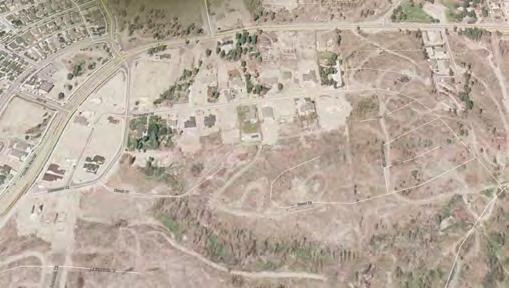2.1.6 Relevant Evidence from Recent California WUI Fires Kasler and Reese (2019) present an analysis by McClatchy of CAL FIRE data and Butte County property records suggesting that 2008 additions to the California Building Code (Chapter 7A) effectively reduced damage to compliant homes built after the code went into effect. The database includes all homes in the Camp Fire perimeter and homes within 100 metres of the perimeter – close enough for embers to spark a new fire (e.g., see ESRI 2020). Syphard and Keeley (2019) analyze building inspectors’ reports documenting homeowner mitigation practices for more than 40,000 wildfire-exposed structures from 2013 to 2018. They find that “structural characteristics explained more of a difference between survived and destroyed structures than defensible space distance [structure ignition zone in National WUI Guide nomenclature]. The most consistently important structural characteristics – having enclosed eaves, vent screens, and multi-pane windows – were those that potentially prevented wind-borne ember penetration into structures, although multi-pane windows are also known to protect against radiant heat.” Active firefighting sometimes proves crucial, but no single building feature appears to dominate survival. Notably, “while destroyed homes were preferentially included in the study, many ‘fire-safe’ structures, having > 30 metres defensible space or fire-resistant building materials, were destroyed.” CAL FIRE (2020) provided the project team with a database of 1,065 buildings located within the boundary of the 2018 Camp Fire that had been inspected the year before the fire and immediately afterwards. The database represents a combination of data from CAL FIRE’s Damage Inspection Specialists (DINS) and Defensible Space (DSpace) databases. Only one field from the DINS data is included: whether the structure was destroyed or undamaged. Structures with intermediate levels of damage were omitted. The database contains twelve fields for each house from the DSpace databases, including the use of the structure, roof construction, eaves, vent screens, exterior siding, windows, deck and porch construction, patio cover construction, and fence construction. The database does not contain data about fuel near the structure. In written and oral communication, Hawks (2020) provided a variety of other valuable information about WUI fires in California between 2013 and 2020. These data are now summarized here. CAL FIRE data shows that 93% of buildings that ignite are destroyed; 5% are affected (meaning repair cost between 1% and 9% of the house replacement cost), and the remaining 2% of buildings experience repair costs that are either minor (10% to 25% of house replacement cost) or major (26% to 50% of house replacement costs) (Steven Hawks, Staff Chief of Wildfire Planning and Engineering Division, CAL FIRE, December 3, 2020, oral commun.). Figure 4A shows that approximately 51% of the 350 single-family homes built after 2008 within the boundary of the 2018 Camp Fire in Northern California escaped damage. Only 18% of the 12,100 homes built prior to 2008 escaped damage. Manufactured houses burned in nearly equal measure regardless of age. Figure 4B (Hawks 2020) shows odds ratios (OR) attributable to various building features and defensible space (DSpace). Whiskers in the chart show the 95% confidence intervals (CI) for the odds ratios. Figure 4C illustrates how compliance with the 2008 California Building Code appears to reduce the likelihood of ignition and degree of damage in each of seven WUI fires. Figure 4D aggregates the data from the seven fires (Hawks 2020). Note that the California Building Code’s requirements and DSpace data map heavily but still imperfectly resemble recommendations of the National WUI Guide. Especially noteworthy is the absence of information about combustible material immediately adjacent to the house, the area that the National WUI Guide refers to as priority zone 1A. Also note the distinction between damage severity and the probability of ignition. Figure 4E shows damage severity conditioned on ignition.
8








